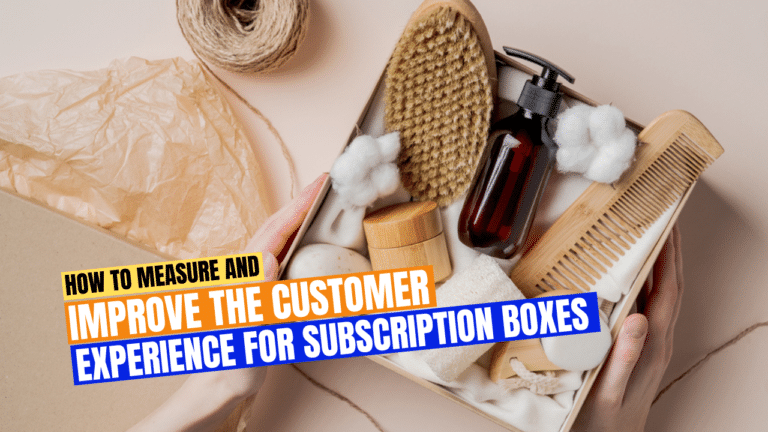Subscription box services have become increasingly popular in recent years, with millions of people subscribing to receive a monthly box of curated products. However, with so many services to choose from, providing a top-notch customer experience is essential for standing out in a crowded market.
We’ll cover the importance of measuring customer satisfaction, collecting and responding to customer feedback, personalization and branding, packaging and shipping, product curation, user interface and customer service, loyalty and referral programs, and data analysis and metrics. By implementing these strategies, you can create a customer experience that fosters long-term loyalty, encourages referrals, and sets your subscription box service apart from the competition.
What Is The Customer Experience?
You may think it is just a buzzword that gets thrown about a lot these days, but the customer experience refers to the sum of all interactions that a customer has with a company or brand, across every touchpoint and channel.
It encompasses every stage of the customer journey, from initial awareness and consideration to post-purchase support and retention. The customer experience can include a range of factors such as the quality of the product or service, ease of use, customer service, pricing, branding, and communication.
A positive customer experience can lead to customer satisfaction, loyalty, and advocacy, while a negative experience can result in customer churn, negative reviews, and damage to a company’s reputation. As such, creating a positive and memorable customer experience is a crucial component of building a successful and sustainable business.
Curating the Customer Experience: How Personalization and Branding Can Set Your Subscription Box Service Apart
Personalization and branding are key components of the customer experience for subscription box services. Personalization refers to tailoring products and services to meet the unique needs and preferences of individual customers, while branding refers to the visual and messaging components that help a business stand out and build a memorable and recognizable identity.
Here are some ways that personalization and branding can help set subscription box services apart and improve the customer experience:
Tailoring the Box to Individual Preferences
One of the key benefits of subscription box services is that they allow businesses to curate products that match customers’ individual preferences. By gathering data on customer preferences, businesses can create boxes that are tailored to individual tastes, which can increase customer satisfaction and foster long-term loyalty.
Branding That Resonates With Customers
Branding is important for setting a subscription box service apart from the competition. By developing a memorable and recognizable brand identity, businesses can create an emotional connection with customers and foster long-term loyalty. Branding includes elements such as logos, color schemes, messaging, and tone of voice.
Creating a Sense of Exclusivity
Subscription box services can create a sense of exclusivity by offering limited edition products or early access to new products. This can help to build excitement and anticipation among customers and foster a sense of community around the service.
Personalized Messaging
In addition to personalized boxes, businesses can create personalized messaging that resonates with individual customers. For example, a business could send a personalized welcome email to new subscribers or birthday messages to customers.
From the Inside Out: How Packaging and Shipping Can Make or Break the Customer Experience
Packaging and shipping are essential components of the customer experience for subscription box services. They can have a significant impact on the overall customer experience and can influence whether a customer decides to continue using a service or recommend it to others.
The packaging of a subscription box can influence the overall first impression that a customer has of the service. If the packaging is well-designed, visually appealing, and conveys a sense of luxury or exclusivity, it can create a positive and memorable experience. On the other hand, if the packaging is low-quality or unappealing, it can create a negative impression and result in customer dissatisfaction.
Shipping is another important component of the customer experience. Fast and reliable shipping is important for meeting customer expectations and can increase customer satisfaction. Delayed or damaged shipments, on the other hand, can result in frustration and disappointment among customers.
In addition to the practical aspects of packaging and shipping, they can also be used to reinforce a subscription box service’s brand identity. For example, a subscription box service focused on eco-friendly products might use sustainable and recyclable materials for packaging and shipping. This reinforces the brand’s values and messaging, which can increase customer loyalty.
How Product Curation Can Elevate the Customer Experience of Subscription Box Services
Product curation is a critical component of the customer experience for subscription box services. The products that are included in a subscription box can greatly influence customer satisfaction and determine whether a customer decides to continue using a service or recommend it to others.
Effective product curation involves selecting products that meet customer needs and preferences while also providing an element of surprise and discovery. Subscription box services should aim to strike a balance between providing familiar products that customers love and introducing new and unique products that customers may not have discovered otherwise.
Effective product curation also involves ensuring that the products are of high quality and aligned with the brand’s values and messaging. This can help to build trust and credibility with customers and reinforce the brand’s identity.
In addition to the products themselves, the way in which they are presented can also influence the customer experience. For example, including a card or booklet with product descriptions and usage instructions can help to enhance the customer’s understanding and appreciation of the products.
Making It Easy: How User Interface and Customer Service Can Enhance the Subscription Box Experience
User interface and customer service are critical components of the customer experience for subscription box services. The user interface includes the design and functionality of the website or any associated apps, the ordering process, and the customer account dashboard, while customer service encompasses all interactions between the customer and the business, including support, problem resolution and order fulfillment for your subscription box.
An intuitive user interface is important for making the subscription box ordering process easy and enjoyable for customers. The website should be designed in a way that is visually appealing and easy to navigate. It should include features that make it easy for customers to browse and filter products, manage their subscription, and cancel or pause their subscription if necessary.
High-quality customer service is also essential for fostering long-term loyalty. Businesses should aim to provide prompt, friendly, and knowledgeable support to customers. This can include providing detailed product information, answering questions about the subscription service, and resolving any issues or complaints that may arise. The customer service team should be responsive to customer inquiries and concerns, and should be empowered to make decisions that benefit the customer.
To design an intuitive user interface and provide high-quality customer service, businesses should take a customer-centric approach. This means putting the customer at the center of all decision-making and prioritizing their needs and preferences. Businesses should gather feedback from customers on an ongoing basis and use that feedback to make improvements to the user interface and customer service processes. They should also invest in training and support for customer service representatives to ensure that they are equipped to provide the best possible support to customers.
Keeping Them Coming Back: How Loyalty and Referral Programs Can Boost the Subscription Box Experience
You know what people love? Being recognized, and loyalty and referral programs can do that for your subscription box service.
Loyalty and referral programs are an effective way to enhance the customer experience and increase customer loyalty for subscription box services. These programs incentivize customers to remain engaged with the brand, refer their friends and family, and continue their subscription over the long term.
Loyalty programs reward customers for their ongoing loyalty and can include benefits such as exclusive discounts, early access to new products, and free shipping. Referral programs, on the other hand, incentivize customers to refer friends and family to the service in exchange for a reward such as a free box or account credit.
Both loyalty and referral programs are effective for increasing customer retention and driving long-term growth. By providing additional benefits and incentives for customers, businesses can foster a sense of community and loyalty, which encourages long-term engagement and repeat business. Additionally, referral programs can help businesses to reach new customers through word-of-mouth recommendations, which can be a highly effective marketing strategy.

There are many effective loyalty program examples for subscription box services, each tailored to the unique needs and preferences of the target audience. Here are some examples of effective loyalty programs:
- Points-based loyalty programs: Points-based loyalty programs allow customers to earn points for various actions, such as making a purchase, referring a friend, or following the brand on social media. Points can then be redeemed for rewards such as discounts, exclusive products, or free boxes.
- Tiered loyalty programs: Tiered loyalty programs offer rewards and benefits based on the level of engagement or spending by the customer. For example, customers who have been with the service for a certain amount of time or who have spent a certain amount may receive higher-level benefits, such as increased discounts, free shipping, or early access to new products.
- VIP programs: VIP programs offer exclusive benefits to a select group of customers, such as those who have been with the service for a certain amount of time or who have spent a certain amount. VIP benefits can include exclusive products, personalized customer service, or early access to new products.
- Social media loyalty programs: Social media loyalty programs encourage customers to engage with the brand on social media by offering rewards such as discounts or free products for following the brand, sharing posts, or leaving reviews.
To design effective loyalty and referral programs, businesses should consider the needs and preferences of their target audience. The rewards and benefits offered should be tailored to the interests and motivations of the target audience and should provide tangible value that encourages ongoing engagement with the brand.
Additionally, businesses should make it easy for customers to participate in the program and track their progress toward rewards. Nothing can chase away otherwise loyal customers faster than a difficult to navigate loyalty program that makes them want to pull their hair out.
How Data Analysis and Metrics Can Drive the Subscription Box Experience
Data analysis and metrics are essential tools for measuring the success of customer experience improvements for subscription box services. By collecting and analyzing data on key metrics, businesses can identify areas for improvement and make informed decisions about how to enhance the customer experience.
There are several key metrics that subscription box services should track to measure the success of their customer experience improvements. These metrics include:
- Churn rate: Churn rate measures the percentage of customers who cancel their subscription over a given period of time. A high churn rate can indicate that customers are not satisfied with the service and may be a signal that improvements are needed.
- Customer acquisition cost: Customer acquisition cost measures the cost of acquiring a new customer, including marketing and advertising costs. Tracking this metric can help businesses to identify the most effective channels for acquiring new customers and make informed decisions about how to allocate resources.
- Customer lifetime value: Customer lifetime value measures the total value of a customer over the course of their relationship with the business. Tracking this metric can help businesses to identify their most valuable customers and tailor their services to meet their needs.
To use data analysis and metrics effectively, businesses should develop a strategy for collecting and analyzing data on an ongoing basis. This may involve using analytics tools to track key metrics and trends over time, conducting surveys or focus groups to gather customer feedback, or using A/B testing to test different service improvements and measure their impact.
In addition to collecting and analyzing data, businesses should use the insights gained from data analysis to make informed decisions about service improvements. For example, if data analysis reveals a high churn rate, businesses may want to investigate the reasons behind this and make changes to the service to address customer concerns. Similarly, if data analysis reveals a high customer acquisition cost, businesses may want to explore more cost-effective channels for acquiring new customers or look for possible waste in their current acquisition channels.
The Future of Subscription Box Services: Enhancing the Customer Experience for Long-Term Success
In conclusion, the customer experience is a critical factor for the success of subscription box services. Businesses that prioritize customer satisfaction and loyalty through effective customer experience strategies are more likely to thrive and grow over the long term.
To improve the customer experience, businesses should focus on several key strategies. These include measuring customer satisfaction through methods such as surveys and net promoter scores, improving the product curation and packaging to create a memorable unboxing experience, providing high-quality customer service and user-friendly interfaces, and implementing loyalty and referral programs. Data analysis and metrics are also essential for measuring the success of customer experience improvements and making informed decisions about how to enhance the service.
By prioritizing the customer experience, subscription box services can foster long-term loyalty, increase customer satisfaction, and ultimately drive growth and success. This requires ongoing effort and attention to detail, as customer preferences and expectations can change over time. However, businesses that are committed to providing a top-notch customer experience will be well-positioned to succeed in this competitive and rapidly evolving market.
As the subscription box industry continues to evolve, businesses that prioritize customer experience will have a competitive advantage. By listening to customer feedback, measuring success through data analysis and metrics, and continually improving the service, subscription box services can provide a unique and memorable experience that keeps customers coming back for more.









